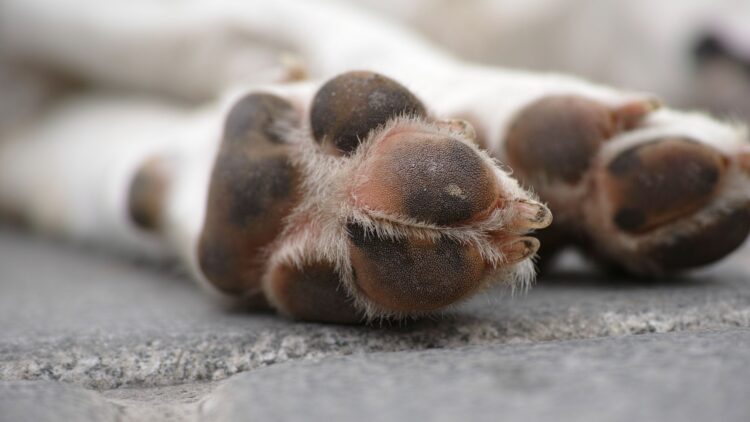Many of us who are dog owners are absolutely obsessed and in love with our pups. There are about 100 times throughout the day when we grab them and snuggle them up to us right in our face. We can’t help but want to love and kiss their faces, their bellies, and their paws.
Dogs are our best friends, the ones who don’t talk back and listen when we vent without giving us unwarranted advice. In addition, they love us unconditionally .
When you snuggle up on your dog, you may notice specific things.

Aside from the licks that we get all over our faces, when we do snuggle up with our dogs, you may notice specific things about their demeanor or even their scent. Dogs have specific scents that we even can catch a mile away. We always know when things are “going on” with our dogs—if, you know, we pay attention.
If you’re a dog owner, I’m sure you’ve noticed that your dog’s paws can oftentimes smell.

If you have ever smelled your dog’s paws, you know because we are all crazy dog owners, you would know that they sometimes smell like chips and popcorn . More specifically, the smell can be compared to that of corn chips—like Fritos.
If you’ve ever been curious about why your dog’s paws smell like this, there’s actually a reason.

Clearly, we love to call our dogs funny names like “Frito Feet,” or “Potatoe Toes,” but many of us have not exactly asked or questioned where the smell comes from. Some of us have just become used to the smell and chalked it up to “dog feet.”
The smell comes from actual bacteria in the dog’s paws.

Like human skin, a dog’s fur and skin have bacteria on them, as well. When the bacteria called Pseudomonas and Proteus are present on their skin, their paws can give off that scent of corn chips that we are always claiming to smell.
Essentially, the odor comes from “yeast.”

Both of the bacteria that are present on their paws indicate an overgrowth of yeast on their paws. Sometimes, it happens a lot when they have been stepping in water or have been licking their feet often.
Another reason why their paws smell like popcorn or chips is because of sweat.

When dogs are out playing and running around, they sweat, just like humans. Except, they don’t necessarily sweat in the same way. Dogs sweat through their paws and that sweat can cause their paws to smell a bit. In addition, when dogs lick their paws, it can also leave behind an odor.
As it turns out, it’s not a huge concern if your dogs have popcorn feet.

Popcorn or Frito paws on your dogs are not a totally big deal and are not a reason to freak out and run to the vet. If you see that there is a small odor, you can let it rock—but, don’t totally ignore it. You should pay attention to your dog’s demeanor and behavior, too.
If you notice a huge change, make sure you note it.

If you notice your dog is licking their paws more often than normal, examine the paw to see everything is okay. If the paw is swollen or inflamed, that’s a concern. In addition, if you see any cuts or scrapes in their paw pads that do not heal, that’s a red flag.
The biggest concern is if there is discharge from their paws.

Any type of discharge coming from their paw is a sure-fire sign of injury and infection. If there is any discharge or pus coming from their paws, you want to call your vet immediately and see when you can be seen. Many times, this will require antibiotics to clear up.
To prevent infection of your furry friend’s paws, you want to keep them clean.

Give your dog baths or take them to the groomer regularly. Making sure that they stay clean will prevent them from getting infections or a build-up of bacteria on their feet. In addition, you want to make sure that when they are done bathing, you dry their feet so that there is no yeast build-up in the dampness.
You can also trim the hair on your dog’s paws and also invest in some booties.

In the snow and rain, getting your dogs some booties can really help to keep their feet dry and clean. Especially in busy areas where salt is an issue, putting on booties can not only protect their feet from the salt burns, but also from the wet snow that can later lead to a yeast infection.

















































